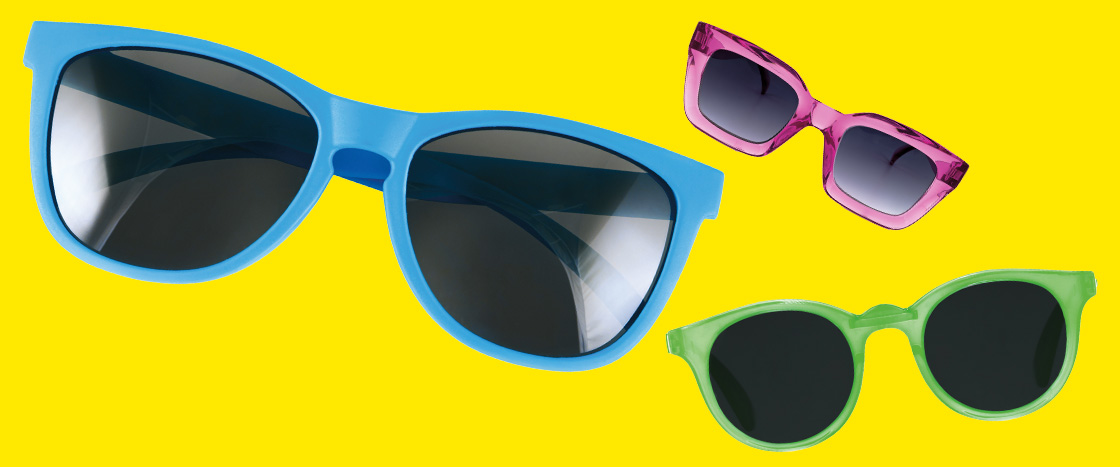It’s a sunny day. You walk outside. Yikes! You squint. The sun is so bright. People have felt this way on sunny days for thousands of years. That’s why we have sunglasses.

The History of Sunglasses
This bright idea has a long history.
Standards
Sunglasses Made of Bone
Believe it or not, sunglasses were first made in a very cold place—Alaska! People called the Inuit (IH-nyoo-wuht) made them 4,000 years ago. Why did people in such a cold place need sunglasses?
It is very snowy in Alaska. The sun shines on all that white snow. It gets really bright. People needed to protect their eyes from the brightness.
The Inuit made sunglasses out of bone. They tied them on with leather strings. These sunglasses had two thin slits over the eyes. People wore them to travel and hunt in the snow.
Sunglasses Made of Rock
People in China made sunglasses 800 years ago. They were more like sunglasses today. The outside part of the glasses, called the frames, were made of metal. The part over the eyes, called the lenses, were made of very thin slices of rock. They were so thin that people could see through them!
Soon people in other places were using sunglasses too.
Sunglasses for Movie Stars
Fast-forward to the 1920s. People loved going to movie theaters. They also loved movie stars. Movie stars often wore sunglasses.
People wanted to look like movie stars, so they wore sunglasses too!
Sunglasses for Pilots
In the 1940s, the U.S. was at war. Pilots were an important part of the war. Pilots wore special, big sunglasses while they flew. They were called aviator sunglasses. “Aviator” is another word for pilot. Today pilots and other people still wear these sunglasses.
Sunglasses Today
Now there are many different kinds of sunglasses. They look cool and keep your eyes safe while you have fun in the sun!
Sunglasses Timeline
Knud Rasmussen/Royal Geographical Society via Getty Images (Bone Sunglasses); © Science Museum/Science & Society PL (Rock Lenses); Archive Photos/Getty Images (Movie Star); Everett Collection/Superstock (Aviator); Shutterstock.com (Modern Sunglasses)
4,000 years ago: bone sunglasses
800 years ago: rock lenses
1920s: movie star sunglasses
1940s: aviator sunglasses
Today: All kinds!
About the Article
Social Studies Focus
Long ago and today
Vocabulary
squint, slits, aviator
Essential Question
The essential question of this issue is How do our lives change in the summer? The articles below connect to this theme.
- Big Read: “Dogs to the Rescue,” p. 6
- Past to Present: “The History of Sunglasses,” p. 22
- Fiction: “The Grasshopper and the Ant,” p. 24
- Debate: “Should Kids Have Later Bedtimes in the Summer?,” p. 30
- Poetry: “Dad in the Sand,” p. 32
Through the above texts, students will dig deep into this essential question and make text-to-text connections.
1. BEFORE READING
Show “The Big Question” Video (10 minutes)
Watch “The Big Question: How Do Our Lives Change in the Summer?” (This video also goes with other stories in this month’s Storyworks 2.)
- Before your students watch, ask them to think about the question “How Do Our Lives Change in the Summer?”
- Watch the video.
- After watching, ask the question again. Write students’ ideas on chart paper.
Text Preview Bookmarks (5-10 minutes)
- Our skills page has both fiction and nonfiction options for kids to cut out to help them preview the text. They can use the nonfiction bookmark for this story.
2. READ THE ARTICLE (10 MINUTES)
- Now tell students they are going to read an article about the history of sunglasses. Students can read the article individually, in small groups, or as a whole class.
3. AFTER READING
Play the Vocabulary Slideshow (3-5 minutes)
- Now that your students have read the article, they have context for understanding the new words that appeared in it. Play the vocabulary slideshow after reading to reinforce these new words. Students can hear the definitions of the words read aloud and see photos illustrating each word. They can also practice saying the words out loud.
4. AFTER READING: FOCUS ON ELA SKILLS (10 MINUTES)
Pick and choose from a variety of activities:
Assessment: Quiz (10 minutes)
- Pass out the quiz to assess comprehension.
- We offer this quiz in multiple-choice and written-answer formats.
ELA Focus: Crossword Puzzle (15 minutes)
- Using the “Sunglasses Crossword Puzzle” printable, students can do a fun crossword puzzle using words from the article.
ELA Focus: Sunny Chart (time amount varies)
- Making text-to-text connections builds knowledge and comprehension. We layer Storyworks 2 with many ways for your students to make connections.
- Kids can compare the texts by using our “Sunny Chart” printable. How are the texts alike, and how are they different?
ELA Focus: Parts of Speech (15 minutes)
- Using the printable “My Sunny Day,” students can fill in the blanks with different parts of speech to create a silly story about a day at the beach.
Whole Issue Scavenger Hunt (15 minutes)
- On our website, go to the Resources section of this article. Scroll down to Activities. The scavenger hunt is there.
- This is a self-contained group of slides that guide students on a scavenger hunt through the whole issue. It helps them make text-to-text connections.
- It can be done independently by students at home or during class time.
